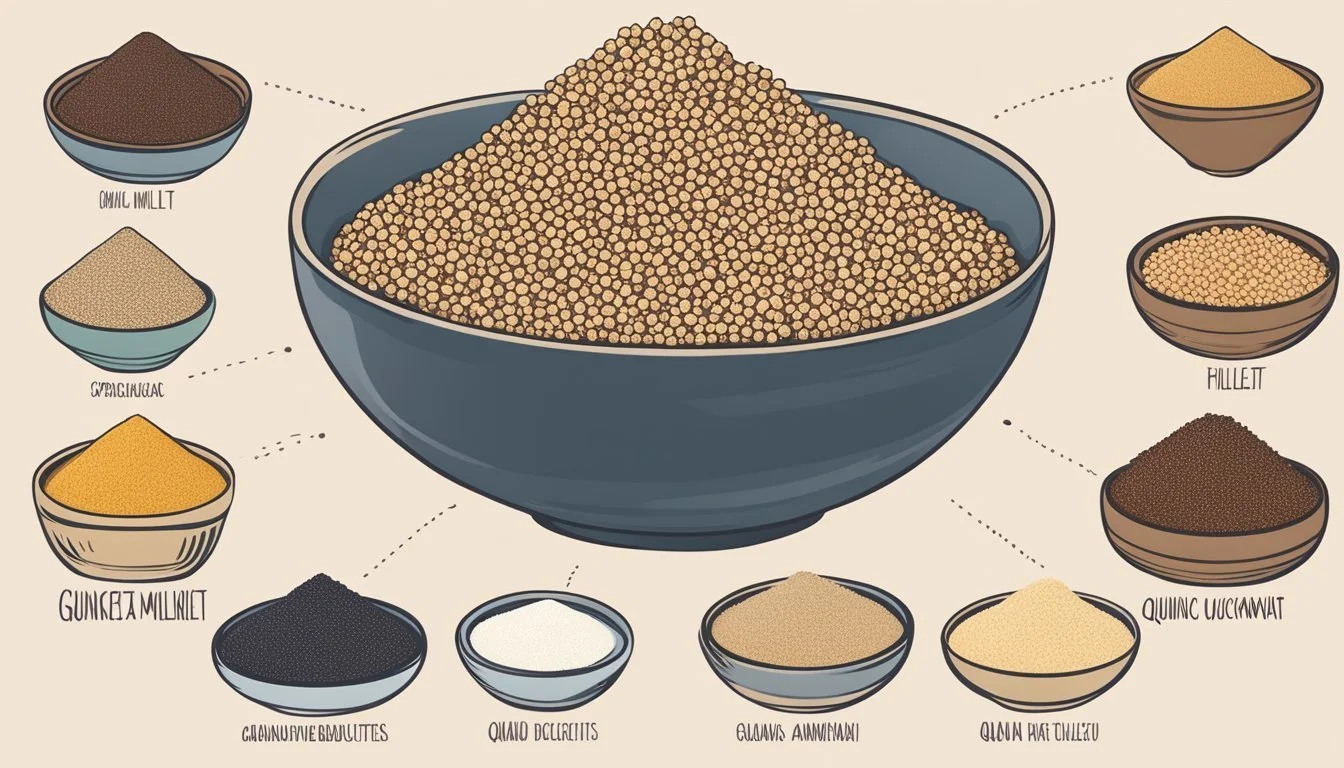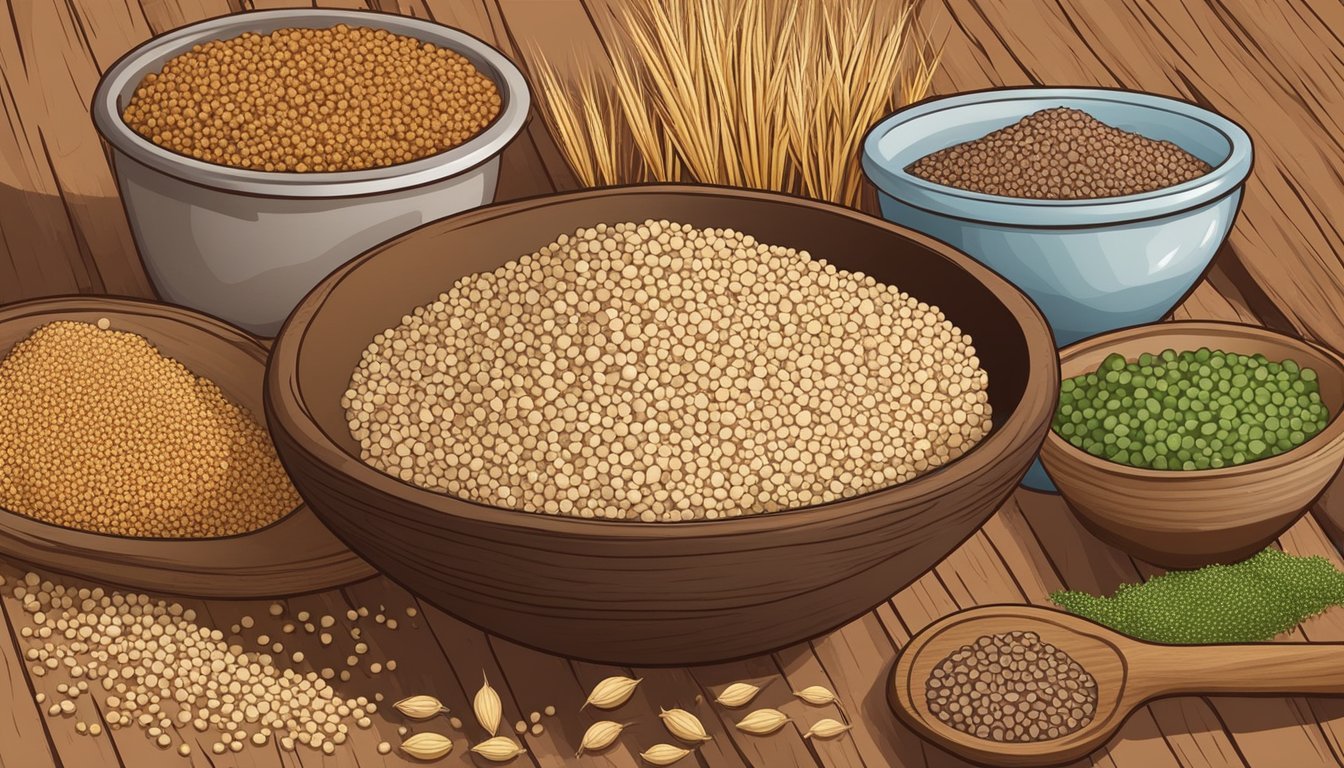Amaranth Substitutes
Top Alternatives for Your Recipes
Amaranth is an ancient grain that was a staple food of the Aztecs and has been cultivated for thousands of years. Known for its rich nutritional profile, amaranth is high in protein, fiber, and essential amino acids. It's valued for its versatility in the kitchen, where it can be used in a variety of dishes, ranging from breakfast porridge to dinner entrées. However, despite its benefits, some may seek alternatives to amaranth due to dietary preferences, availability issues, or simply for the sake of culinary experimentation.
Substitutes for amaranth can serve various purposes, whether to mimic its texture, taste, or nutritional components. Grains like quinoa and millet can replace amaranth as they share a similar size and cook in comparable ways. Quinoa, also an ancient grain, provides a complete protein source, while millet is appreciated for its mildly sweet flavor. For those avoiding gluten or aiming to enhance specific nutritional aspects in their dishes, alternatives such as soy flour, buckwheat, and chia seed flour can be suitable replacements, providing similar health benefits without compromising on the desired culinary results.
In recipes where amaranth flour is used, it's important to consider the end-product's texture and binding ability. Soy flour can be used for its protein content and gluten-free properties, but it's advised to limit its use to ensure that the texture of the baked goods is not too dense. Similarly, other substitutes like coconut flour and chia seed flour may require adjustments in the ratio and additional binding agents. These considerations ensure that the integrity of the dishes is maintained, making the substitute grains and flours practical alternatives to amaranth.
Understanding Amaranth
Amaranth is a versatile and nutrient-rich pseudocereal that has been lauded for its remarkable health benefits and vast culinary applications. It is known for being a gluten-free grain alternative with a rich history that spans continents.
Historical Significance
Amaranth was a staple in the diet of the Aztec civilization and has been cultivated for thousands of years. Referred to as an "ancient grain," though technically not a grain but a seed, its significance extends to various cultures, including those in Africa, where it remains a vital food source.
Nutritional Profile
Amaranth is celebrated for its dense nutritional content, providing a source of protein, fiber, vitamins, and minerals.
Protein: It is one of the few plant sources that contain all essential amino acids.
Fiber: High in dietary fiber, aiding in digestion.
Vitamins & Minerals: Especially rich in vitamins such as A and C, and minerals including:
Mineral Importance Iron Oxygen transportation in blood Magnesium Muscle and nerve function Phosphorus Energy storage and use
Amaranth also boasts a notable presence of antioxidants, compounds that can help prevent oxidative damage in the body.
Culinary Uses
As a gluten-free grain alternative, amaranth has found its way into various recipes, ranging from energy bars to hearty meals. Amaranth flour has become a popular substitute in gluten-free baking. It holds moisture well, making it suitable for recipes that require a certain density, such as bread and muffins. Amaranth can also be popped like popcorn, cooked into porridge, or used as a thickener for soups and stews. Its nutty and somewhat earthy flavor allows it to blend well with both sweet and savory ingredients.
Reasons for Substituting Amaranth
The necessity to find an amaranth substitute may arise from flavor preferences, texture differences, and dietary restrictions. Various alternatives cater to these considerations while maintaining the integrity of the original dish.
Flavor Preferences
A distinct nutty flavor characterizes amaranth, which might not align with everyone's palate. Some people may seek a milder taste or an alternative with a subtle sweetness. On the other hand, the earthy tones of amaranth can be overpowering, and a substitute with a more neutral flavor profile may be desired.
Texture Differences
Amaranth's texture contributes appreciably to its culinary uses; however, it may not be suitable for every recipe. One might look for a substitute that lends a lighter, airier texture to baked goods. Factors such as moisture absorption are pivotal when choosing a replacement to achieve the desired consistency.
Dietary Restrictions
Individuals with dietary restrictions may need gluten-free options. While amaranth is gluten-free, those with sensitivities or allergies to amaranth require alternatives. Substitutes like coconut flour or chia seeds provide a gluten-free solution that caters to health needs without compromising on nutrition.
Popular Amaranth Substitutes
When seeking alternatives to amaranth, several grains stand out for their nutritional value and ease of substitution. These substitutes often share a similar profile in terms of protein and fiber content, while adding their own unique flavors and textures to a variety of dishes.
Quinoa
Quinoa is an ancient grain with a similar nutritional profile to amaranth, making it an excellent substitute. It is high in protein and fiber, with a slight nutty flavor. Quinoa, being gluten-free, is a versatile grain that can be used in both sweet and savory dishes. It cooks up with a fluffy texture and is known for its earthy taste.
Buckwheat
Despite its name, buckwheat is not related to wheat and is naturally gluten-free. It presents a robust, earthy flavor and a soft yet slightly grainy texture. Buckwheat is rich in protein and offers a good dose of fiber, making it a substantial substitute for amaranth.
Millet
Millet is a small-seeded grain that serves as a great alternative to amaranth. It cooks to a light and fluffy texture and carries a subtly sweet and nutty taste. Millet is gluten-free and can complement various recipes, enhancing meals with its nutritional profile similar to amaranth.
Rice
Rice is a widely available substitute for amaranth, with brown rice being particularly nutritious. It has a milder flavor but can imbibe a variety of taste profiles, making it a versatile option in the kitchen. Rice offers a unique texture and can be used as a substitute in most recipes where amaranth is called for.
Chia Seeds
Chia seeds are small yet packed with nutrients, boasting high levels of fiber and protein. They share a comparable nutritional profile with amaranth and can absorb a lot of liquid, developing a gel-like texture. Chia seeds are an easy-to-find gluten-free alternative that can be used in a plethora of recipes, especially for thickening or as an additive in baked goods.
Alternative Grains and Flours
Choosing the right substitute for amaranth flour hinges on the desired nutritional benefits, taste profile, and whether the recipe requires a gluten-free option. This section explores various grains and flour alternatives suited for different culinary applications, from baking to thickening sauces.
Grains in Detail
Quinoa Flour: A complete protein source and gluten-free, quinoa flour can replace amaranth flour for a slightly nutty flavor. It's ideal for sweet and savory dishes alike.
Buckwheat Groats: Ground into flour, buckwheat can be used in pancakes and has a distinct, slightly bitter flavor.
Barley Flour: Rich in fibers, barley flour offers a sweet and nutty essence, suitable for baking. However, it contains gluten, which isn't ideal for all dietary requirements.
Non-Grain Flours
Chickpea Flour: With more protein than amaranth, chickpea flour is excellent for hearty, savory dishes but should be used sparingly to avoid a robust flavor.
Coconut Flour: High in fiber and protein, coconut flour is a sweet, gluten-free substitute that works well for baked goods and pancakes, but requires additional liquid in recipes.
Specialized Gluten-Free Flours
Soy Flour: A protein-rich option, suitable for gluten-free baking up to a 30% replacement rate in many recipes to retain structure, especially in yeast breads where it should be limited to 15%.
Cassava Flour: A good alternative for those needing a gluten-free option that resembles wheat flour in texture, making it a versatile pantry staple.
Sorghum Flour: It adds a mild, sweet flavor to gluten-free recipes and can be used in sauces or as a thickener.
Each flour offers unique properties, and one should adjust recipes accordingly to achieve the best results while maintaining the integrity of the dish.
Cooking and Baking with Substitutes
When incorporating amaranth substitutes into cooking and baking, it's crucial to consider how these alternatives will affect flavor and texture. Substitutes can offer a range of benefits from added protein to gluten-free options, yet each brings a distinct taste and structural quality to dishes.
Grain Alternatives for Meals
Amaranth is often used for its nutty flavor and high nutritional content in a variety of meals such as soups, stews, and side dishes. When seeking grain substitutes for amaranth in cooking, consider the following options:
Quinoa: A protein-rich seed that cooks up fluffy and can be used in a 1:1 ratio for amaranth in most recipes. It's excellent in salads, side dishes, and as a thickening agent in soups and sauces.
Buckwheat: Despite its name, buckwheat is gluten-free and offers a robust flavor suitable for hearty dishes.
Couscous: Although not gluten-free, couscous can be a suitable substitute in dishes where a lighter texture is desired, such as salads or as a bed for sauces.
Incorporating these grains into meals can maintain the integrity of the dish while also providing new flavors and textures.
Flour Alternatives for Baking
When replacing amaranth flour in baking, the goal is to preserve the desired consistency of the final product, whether for pancakes, pasta, or sweet and savory baked goods. Flour substitutes vary in their properties, and adjustments may be necessary:
Soy Flour: This gluten-free option should be limited to 30% of the total flour content in recipes for optimum structure, especially in yeast breads where no more than 15% is advisable.
Coconut Flour: A high-fiber, high-protein alternative that can replace amaranth flour at a 1:1 ratio, mindful that its high absorbency may require additional liquid in the recipe.
Chia Seed Flour: With a similar nutritional profile to amaranth, chia seed flour can be used in a variety of baking applications for both sweet and savory dishes.
Experimenting with these flour alternatives allows for varied baking results that cater to dietary preferences without compromising taste.
Nutritional Benefits of Substitutes
Amaranth flour is renowned for its robust nutritional profile, offering significant health benefits. Substitutes for amaranth are chosen not only for their textural similarities but also for their comparable nutrition, including protein and fiber content, as well as a wealth of vitamins, minerals, and antioxidants.
Protein and Fiber Content
Substitutes such as quinoa and chia seeds are exceptional sources of protein and dietary fiber, contributing to muscle repair and digestive health. For instance, quinoa offers around 4 grams of protein and 2.5 grams of fiber per cooked 1/2 cup serving. Chia seeds provide about 2 grams of protein and a remarkable 11 grams of fiber per ounce, making them a powerhouse for those seeking to maintain a nutritious diet.
Vitamins and Minerals
The amaranth substitutes shine with a spectrum of micronutrients important for bodily functions. Quinoa is an excellent source of magnesium and iron, with one serving containing nearly 30% of the daily value for magnesium and 15% for iron. Buckwheat, another apt alternative, is rich in B-vitamins that support energy metabolism.
Antioxidant Properties
Antioxidants play a crucial role in combating oxidative stress and promoting overall health. Buckwheat groats stand out for their antioxidant properties, particularly the compound rutin, which can help strengthen blood vessels. Chia seeds are also known to be rich in antioxidants, which contribute to their nutritional benefits and have made them an increasingly popular choice among health-conscious consumers.
Incorporating Substitutes into Your Diet
When looking to replace amaranth in a diet, it's essential to select alternatives that provide a similar nutritional profile, including proteins and key nutrients. The substitutes should also align with culinary uses, whether in vegan cooking or baking.
Meal Planning with Alternatives
In meal planning, it's important to incorporate grains and pseudocereals that match amaranth's nutritional benefits. Quinoa, for instance, is an excellent substitute as it closely mirrors amaranth's protein content. Grains like farro and barley can serve as hearty side dishes, while buckwheat groats can be a base for salads and soups.
Sample Meal Plan Incorporating Amaranth Substitutes:
Breakfast: Quinoa porridge topped with fresh fruits.
Lunch: A farro and roasted vegetable salad.
Dinner: Barley risotto with mushrooms and greens.
Creative Uses in Recipes
Substitutes can be integrated creatively into various recipes to maintain texture and flavor. For baking, amaranth flour can be replaced with quinoa flour in a 1:1 ratio, complementing the structure of breads and the moisture in cakes and cookies. Chia seeds can be a direct replacement in stews and soups due to their similar texture.
Examples on Utilizing Amaranth Flour Substitutes in Baking:
Bread: Substitute up to 25% of wheat flour with quinoa flour.
Cookies: Use a mix of half wheat flour and half quinoa flour.
By selecting the right amaranth substitutes, one can continue to enjoy a variety of meals and baked goods with a comparable taste and nutritional value.
The Global Influence of Amaranth
Amaranth has traversed from its ancient roots to modern-day global cuisine, marked by its adaptation in various cultures and the rise in the use of its substitutes.
Amaranth in Various Cultures
Originally cultivated by the Aztecs approximately 8,000 years ago, amaranth was a staple in their diet and rituals. In Africa, this grain-like seed has been used similarly to sorghum and millet. Indian cuisine incorporates amaranth in a multitude of dishes, often during fasting periods, showcasing its versatility. Popped amaranth is another form enjoyed globally, akin to popcorn, yet packed with nutrients.
Adoption of Amaranth Substitutes Abroad
The nutritional profile and gluten-free nature of amaranth have led to its substitutes becoming prominent in international culinary spheres. For example, quinoa, also a seed, has seen widespread adoption due to its similar protein content. Wild rice and farro are adopted for their hearty texture in Western countries, while buckwheat and teff are appreciated for their unique flavors and health benefits. Substitutes like bulgur and couscous, although not gluten-free, offer similar quick-cooking convenience.
Conclusion
When considering alternatives to amaranth, one has a variety of options that can cater to both nutritional needs and culinary applications. Substitutes such as quinoa, buckwheat groats, and chia seed flour not only offer similar nutrient profiles, complete with essential amino acids and fiber, but also maintain the heartiness required in dishes traditionally made with amaranth.
For those seeking gluten-free options, brown rice, sorghum, and teff provide safe and wholesome alternatives. Each brings unique health benefits while allowing individuals with gluten sensitivities to enjoy a range of recipes.
Below is a summary of notable substitutes for amaranth, considering their nutritional similarity and culinary versatility:
Substitute Nutritional Aspect Best Used For Quinoa High in protein Salads, pilafs Buckwheat Groats Rich in minerals Porridge, sides Chia Seed Flour Omega-3 fatty acids Baked goods Brown Rice Fiber-rich Stir-fries, side dishes Soy Flour Protein boost for baking Breads, baked goods
Coconut flour, while not nutritionally identical to amaranth, is another available alternative, especially in terms of texture and cost-effectiveness for baking needs.
Chefs and home cooks adapting recipes with these substitutes should consider the individual characteristics of each alternative, particularly in terms of taste and cooking times, to achieve the desired results while reaping the associated health benefits.









